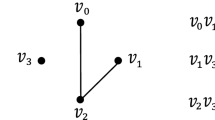Abstract
Spanning connectivity of graphs has been intensively investigated in the study of interconnection networks (Hsu and Lin, Graph Theory and Interconnection Networks, 2009). For a graph G and an integer s > 0 and for \({u, v \in V(G)}\) with u ≠ v, an (s; u, v)-path-system of G is a subgraph H consisting of s internally disjoint (u,v)-paths. A graph G is spanning s-connected if for any \({u, v \in V(G)}\) with u ≠ v, G has a spanning (s; u, v)-path-system. The spanning connectivity κ*(G) of a graph G is the largest integer s such that G has a spanning (k; u, v)-path-system, for any integer k with 1 ≤ k ≤ s, and for any \({u, v \in V(G)}\) with u ≠ v. An edge counter-part of κ*(G), defined as the supereulerian width of a graph G, has been investigated in Chen et al. (Supereulerian graphs with width s and s-collapsible graphs, 2012). In Catlin and Lai (Graph Theory, Combinatorics, and Applications, vol. 1, pp. 207–222, 1991) proved that if a graph G has 2 edge-disjoint spanning trees, and if L(G) is the line graph of G, then κ*(L(G)) ≥ 2 if and only if κ(L(G)) ≥ 3. In this paper, we extend this result and prove that for any integer k ≥ 2, if G 0, the core of G, has k edge-disjoint spanning trees, then κ*(L(G)) ≥ k if and only if κ(L(G)) ≥ max{3, k}.
Similar content being viewed by others
References
Bondy, J.A., Murty, U.S.R.: Graph Theory. Springer, New York (2008)
Cai L., Corneil D.: On cycle double covers of line graphs. Discrete Math. 102, 103–106 (1992)
Catlin P.A.: A reduction method to find spanning eulerian subgraphs. J. Graph Theory 12, 29–45 (1988)
Catlin P.A., Han Z., Lai H.-J.: Graphs without spanning eulerian subgraphs. Discrete Math. 160, 81–91 (1996)
Catlin, P.A., Lai, H.-J.: Spanning trails joining two given edges. In: Alavi, Y., Chartrand, G., Oellermann, O., Schwenk, A. (eds.) Graph Theory, Combinatorics, and Applications, vol. 1, pp. 207–222, Kalamazoo (1991)
Chen Z.-H., Lai H.-J., Lai H.Y.: Nowhere zero flows in line graph. Discrete Math. 230, 133–141 (2001)
Chen, Y., Lai, H.-J., Li, H., Li, P.: Supereulerian graphs with width s and s-collapsible graphs (2012, submitted)
Gould R.: Advances on the Hamiltonian problem—a survey. Graphs Combin. 19, 7–52 (2003)
Gu, X., Lai, H.-J., Yao, S.: Characterizations of minimal graphs with equal edge connectivity and spanning tree packing number (submitted)
Harary F., Nash-Williams C.St.J.A.: On eulerian and hamiltonian graphs and line graphs. Can. Math. Bull. 8, 701–709 (1965)
Hsu, L.-H., Lin, C.-K.: Graph Theory and Interconnection Networks. CRC Press, Boca Raton (2009).
Huang P., Hsu L.: The spanning connectivity of the line graphs. Appl. Math. Lett. 24(9), 1614–1617 (2011)
Jaeger, F.: Nowhere-zero flow problems. In: Beineke, L.W., Wilson, R.J. (eds.) Topics in Graph Theory, vol. 3, pp. 70–95. Academic Press, London (1988)
Lai H.-J., Li P., Liang Y., Xu J.: Reinforcing a matroid to have k disjoint bases. Appl. Math. 1, 244–249 (2010)
Li, P.: Bases and cycles in matroids and graphs. Ph. D. Dissertation, West Virginia University (2012)
Liu D., Lai H.-J., Chen Z.-H.: Reinforcing the number of disjoint spanning trees. Ars Comb. 93, 113–127 (2009)
Nash-Williams C.St.J.A.: Edge-disjoint spanning trees of finite graphs. J. Lond. Math. Soc. 36, 445–450 (1961)
Seymour, P.D.: Sums and circuits. In: Bondy, J.A., Murty, U.S.R. (eds.) Graph Theory and Related Topics, pp. 342–355. Academic Press, New York (1979)
Shao, Y.: Claw-free graphs and line graphs. Ph. D. Dissertation, West Virginia University (2005)
Szekeres G.: Polyhedral decompositions of cubic graphs. Bull. Aust. Math. Soc. 8, 367–387 (1973)
Thomassen C.: Reflections on graph theory. J. Graph Theory 10, 309–324 (1986)
Tutte W.T.: On the imbedding of linear graphs into surfaces. Proc. Lond. Math. Soc. Ser. 2(51), 464–483 (1949)
Tutte W.T.: On the problem of decomposing a graph into n connected factors. J. Lond. Math. Soc. 36, 221–230 (1961)
Zhan S.M.: Hamiltonian connectedness of line graphs. Ars Comb. 22, 89–95 (1986)
Author information
Authors and Affiliations
Corresponding author
Rights and permissions
About this article
Cite this article
Chen, Y., Chen, ZH., Lai, HJ. et al. On Spanning Disjoint Paths in Line Graphs. Graphs and Combinatorics 29, 1721–1731 (2013). https://doi.org/10.1007/s00373-012-1237-0
Received:
Revised:
Published:
Issue Date:
DOI: https://doi.org/10.1007/s00373-012-1237-0




